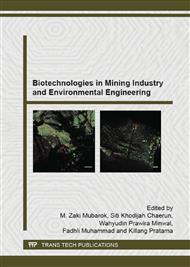p.547
p.551
p.555
p.560
p.564
p.568
p.572
p.577
p.581
Metal Removal from Spent Catalyst Using Microbacterium liquefaciens in Solid Culture
Abstract:
The purpose of the present study was to investigate the ability of Microbacterium liquefaciens strain MNSH2-PHGII-2, isolated from a Mexican silver mine, for removing Ni and V from spent catalyst at 80% (w/v) pulp density in a glass-column system at laboratory conditions. Firstly, microbial culture was adapted to spent catalyst at 0.1% (w/v) in liquid culture then, it was assayed by its ability to remove Ni and V from a spent catalyst in a glass-column system. Spent catalyst was packed at 80% (w/v) pulp density and inoculated at 20% (3x108 CFU/ml); air was supplied at 80 ml/min and then incubated at 30°C during 14 days. Parameters such as microbial growth, pH, Ni and V residual concentrations, in catalyst, were determined at days 7 and 14. The result showed that Microbacterium liquefaciens strain MNSH2-PHGII-2 in the glass-column system was able to remove 1007.4 mg/kg of Ni while V was removed at an extent of 5360.5 mg/kg. Microbial removal for other metals in catalyst was non-significant, that indicated the specificity of Microbacterium liquefaciens to remove Ni and V.
Info:
Periodical:
Pages:
564-567
Citation:
Online since:
November 2015
Keywords:
Price:
Сopyright:
© 2015 Trans Tech Publications Ltd. All Rights Reserved
Share:
Citation:


